by Sam Tackeff | Dec 18, 2013 | Blogging, Books, Gifts, omnivore books
This review was originally published over at Medium – a new-ish publishing platform that I’ve been playing with for the past few weeks. Medium has a clean, streamlined user interface which is quite conducive to both reading, writing and editing. This was my first post on Medium, but I couldn’t help cross posting here as well – it’s too important of a topic for me to leave off of the second lunch.
Melt: The Art of Macaroni and Cheese
When friends create something great — there is the perfect Yiddish word to describe it: naches.
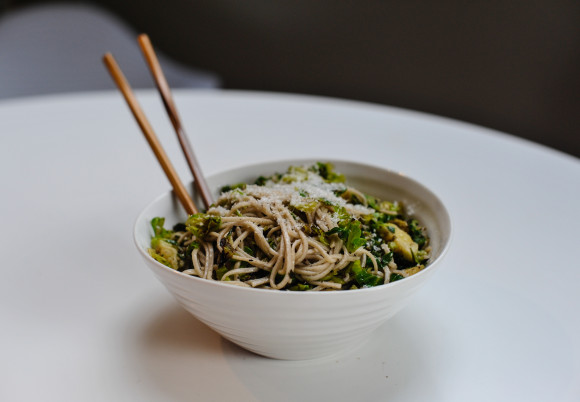
Five years ago, working at Omnivore Books, I started collecting cookbooks in earnest. I do my best to acquire a wide variety of subjects for my collection to learn as much as possible, and while doing so I am picky. I do my research. I avoid superfluous acquisitions. At this point, due to constraints in space and time, every new cookbook needs to matter. At Omnivore, I was in the right place at the right time — surrounded by people who cared about food as much as I did, and my desire for cookbooks became as voracious as my appetite. (It didn’t hurt that I could acquire books at cost — thank you Celia — and received many a review copy). My favorite cookbooks are the ones that tell great stories, are personal, and are unique to a time and a place.
After years of reading brilliant works: Nigel Slater, Paula Wolfert, Melissa Clark, Suzanne Goin, and Patience Grey to name a few, I started getting the itch. I wanted to write my own cookbook. I wanted to contribute to the literary canon. To write a cookbook you need a topic, an outline, and a collection of recipes. To write a great cookbook, you need a purpose, a sense of wonder, passion, and adventure, work ethic, and commitment to creating something truly marvelous. You need community — the people around you are just as much a part of the story. Anyone can write a cookbook, but to write a great cookbook takes so much more. For me, the task seemed daunting. After fretting about the magnitude of taking on a cookbook, I decided to repress my urges.
Over the past year, several of my acquaintances and friends have had proposals accepted, their first cookbooks published, and have even made the New York Times and Amazon bestseller lists. The flickering desires may be returning.
———
I met Stephanie Stiavetti in 2009, soon after I moved to the West Coast — I remember it vividly: I was invited to wine dinner at a swank San Francisco restaurant where I knew no one, and immediately felt awkward walking through the door. Wide-eyed and a little panicked, I stepped out into the hallway to breathe and there was this tiny force who saved me from loneliness. Her blog was called Wasabimon (now The Culinary Life), and I knew immediately that I’d like her. We passionately discussed food, technology, family, and then somehow this new acquaintance in an instant became a dear friend. It wasn’t until after I left San Francisco that I started reading Garrett’s blog — this too I remember clearly, because I read a single weekly post and proceeded to start right from the beginning and read the blog for hours over the course of a weekend like a novel. (Incidentally, I love doing this, but I feel like most bloggers would cringe at the thought of someone reading a post of theirs from five years back.)
When Stephanie and Garrett sold their proposal, I was thrilled! And, yet, I’ll be quite honest here: when I heard that it was going to be about macaroni and cheese, I was skeptical. There’s a fine line with monographs — single subject cookbooks have a tendency to be flash in the pan, trendy topics that end up remaindered. The lucky ones though, rise as the true authority on the topic, and these are the ones that I spend a good amount of time trying to collect. [Spoiler alert: Melt is the latter].
Melt isn’t really a book about macaroni and cheese. It’s a book about cheese, about discovery, and pushing boundaries in the kitchen. It’s a book for people who truly love food, who will seek out new flavors, and take risks. The recipes, while many of them are quite simple to make, are new, innovative, and may even seem a little bizarre. Risk in a cookbook is hard — as a home cook with a new book in hand you have to place a good deal of trust in the author. And with these two, I do.
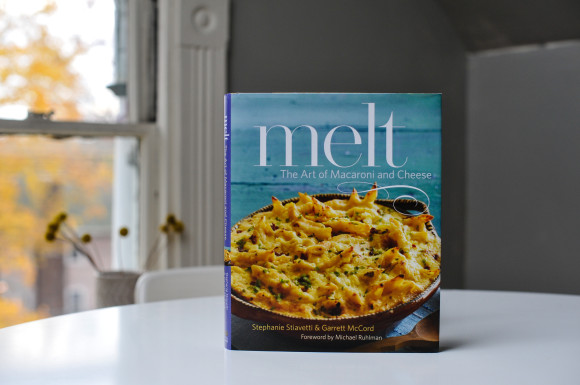
At the core of this book is cheese. And it comes at a good time — cheese lovers these days have much to get excited about. In Boston, we are truly lucky to have Formaggio Kitchen in the neighborhood, where Ishan Gurdal and his family have been building something very special these past twenty years. Formaggio is one of my second homes; their cheese cave rivals none.
For those not lucky enough to live by big city shops, no longer does one have to suffer with supermarket brick cheese as the primary option — many of the great cheesemongers including Formaggio, Murray’s, and Zingerman’s will ship. (I’d be remiss not to mention that Kirsten Jackson, who helped develop many of the pairings in this cookbook book has just started her own cheese of the month club.)
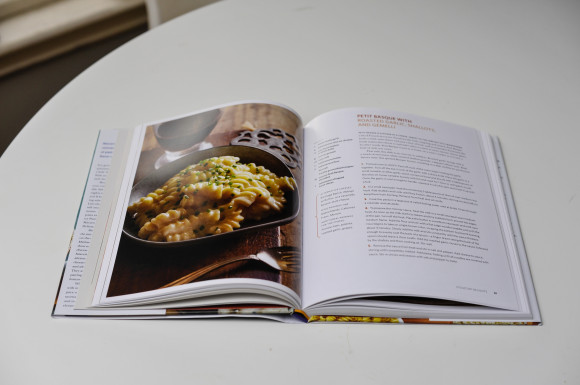
Photos shot and styled by the talented Matt Armendariz /Adam Pearson— make every recipe stand out
The truth is, I don’t usually write much about cookbooks because reviews make me nervous. To do a book justice, you have to write critically — and writing critically of people you hero-worship is a challenge. But here I’ll try to do my best, to share a taste of the cookbook, and the recipes within.
Melt is divided into five main chapters — the first one is 25 pages about the basics — how cheese is made, types of cheese, sourcing cheese, cooking with cheese, pasta, and cooking methods. The second chapter is completely devoted to salads with cheese and pasta. The third ‘Stovetop Delights’ has many of the more classic recipes you’d think of as macaroni and cheese. There are hearty recipes, and a chapter of desserts.
Each recipe has suggestions for alternative cheeses, wine pairings, and additional pairings for the cheese. The breadth of information in this book is quite impressive, but to give a better picture, I cooked through several recipes.
———
After reading through Melt from cover to cover, the first recipe that I tried was one of Garrett’s (the two split headnote writing duties) — soba noodles with parmesan and pan-seared brussels sprouts (pictured up top), one of those dishes that I almost always have the ingredients for: soba, oil, brussels sprouts, salt, pepper, chili flakes, garlic, and cheese. I loved the recipe because it was simple — and lately simple has been all that I’ve had time to make.
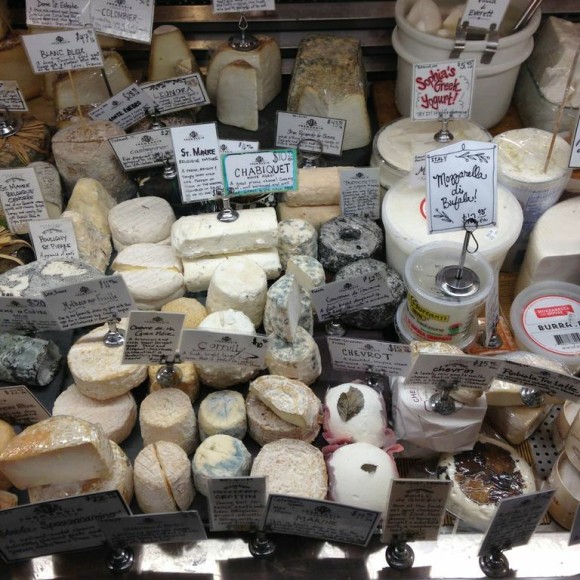
The case at Formaggio Kitchen
After the first attempt was a success — I wanted to push the boundaries a little bit, explore new cheeses I hadn’t tried. There are flavor combinations in Melt that are unlike anything I’ve ever tasted, and so many of them looked enticing. Would it be the chocolate pasta with Bucherondin, hazelnuts, and cherries? Or the Rogue River Blue with crab sauce over fettucine which looked awfully good, as did the Beecher’s Flagship Cheddar, with avocado, lime, and shell pasta. And then there was the Roquefort macaroni with beets, shallots, and poppy seeds. Or maybe thepaneer korma with idiyappam noodles. And then there were the smoked Idiazabal mason-jar potpies with lamb and tomato sauce. These were so cute, I couldn’t stand it.
I finally landed on a dish that was too exciting to pass up: the chicken breast stuffed with Leonora goat cheese, star pasta, and crushed gingersnaps. Leonora was a new-to-me cheese, a citrus-y goat cheese from the Léon region of Spain. The headnote, Stephanie’s this time, was alluring — magical.
The only tweak I made was to use chicken thighs instead of breasts, because, well, I think that white meat chicken is a waste of time, and the thighs are so much more robust. Heh.
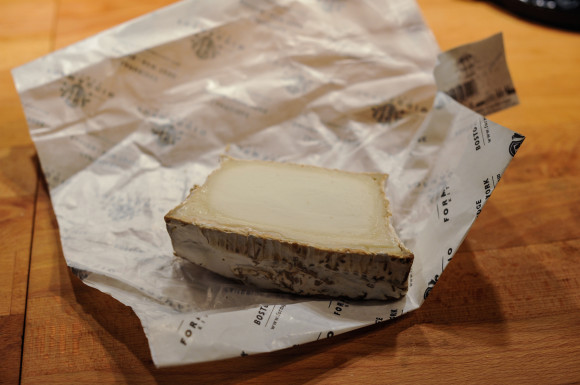
Leonora cheese
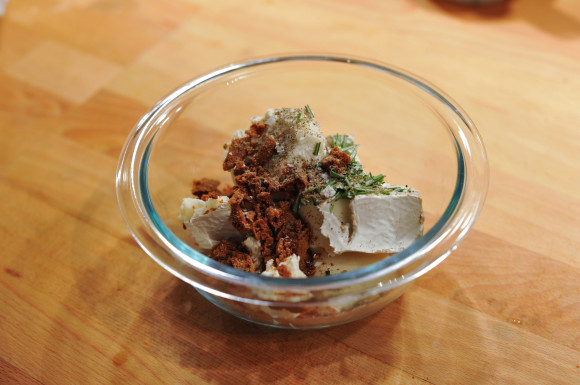
Leonora, Rosemary and Gingersnaps
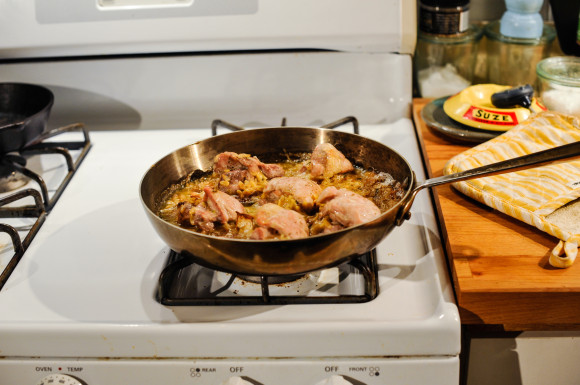
Chicken stuffed with Leonora cheese, rosemary, orzo, and gingersnaps.
I admit that while making this recipe, I was nervous— sure everything smelled delicious, but could I convince my better half that a dish that included a good amount of pungent goat cheese rind (you keep it in), and crushed cookies would actually be edible? Knowing that perception is half the battle, I decided to bite my tongue and just serve our meal. We tucked in, the bowls were finished, and the only critique being that the meal was a tad rich. (In my excitement, I had neglected to cook any vegetables.) Score #2 for my testing.
Another evening, the weather was cold, and I decided to try the tomato soup with star pasta and Vella dry jack crisps. I couldn’t find Vella Jack anywhere, so I ended up making the crisps with parmesan, one of the suggested alternatives. Normally when I want tomato soup, I take a jar of Rao’s tomato sauce, and thin it down with a little water. It does the trick, but comes at a steep cost, as Rao’s is priced high enough to put one into debt, quickly. This recipe was easy to make, getting depth of flavor from roasting canned tomatoes in the oven before starting the soup.
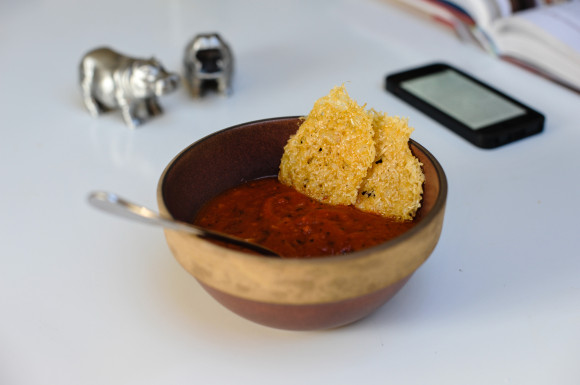
The cheese crisps too are remarkably easy: preheat the oven to 350 degrees, line a baking tray with parchment or a silicon mat, and bake little mounds of shredded cheese for 13-15 minutes until they crisp up. (I only had foil, and this still worked brilliantly.)
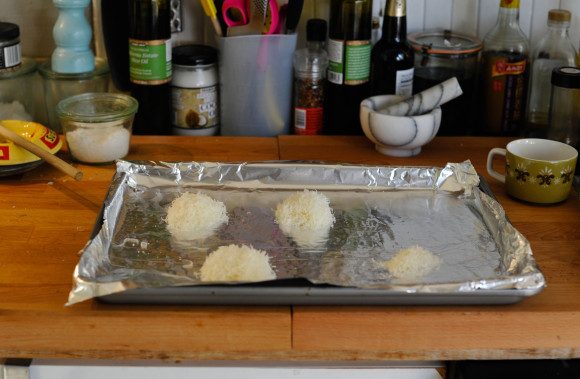
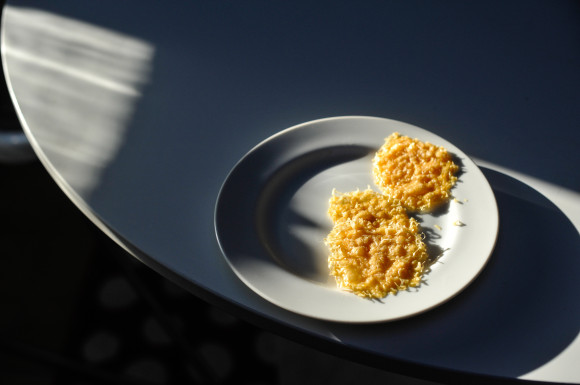
After three successes, and so many more recipes that I’d like to try, I’m able to say confidently that this book is well worth the purchase. It’d make a nice addition to the piles of cookbooks you’ll be giving underneath the Christmas tree. Or maybe consider it for a late Hanukkah gift. Or New Years. Or screw gift giving, and buy it for yourself.
What I’m even more excited about is that this is the very beginning — I’m already looking forward to the next volumes of Stephanie and Garrett that will grace my shelves.
Melt: The Art of Macaroni and Cheese
by Stephanie Stiavetti and Garrett McCord
Published by Little, Brown and Company
224 pages
by Sam Tackeff | Jan 29, 2011 | Baking, Challenge, Cookies, omnivore books
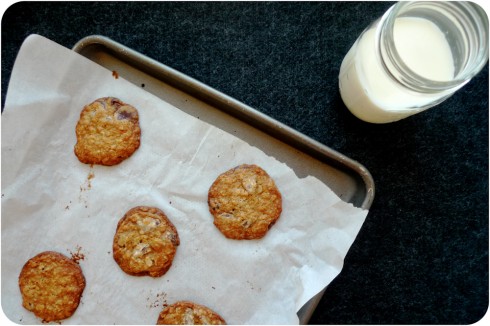
Hint To Self #324: If you are hosting a cookie competition, there is no way in hell that you will not eat dozens of delicious cookies. Your plan of 3-5 cookie samples is an outrageous underestimation of the truth, and a lie to yourself. You’ve learned this at countless previous competitions. Plan accordingly.
But, before I re-cap the hardcore competition (yeehaw!), I want to take a quick moment of reflection. Today, a reader who shall go nameless, actually apologized for commenting so often on my blog, and let me know that she hoped I didn’t think she was crazy. This actually made me a little sad, because it couldn’t be farther from the truth. I can’t thank you all enough for coming and reading my blog. The reality is, every time I read a comment, my heart fills with joy. And yes, that even goes for my mom, who I know has been reading every single post dutifully since the beginning.
My first attempts at blogging as a teenager were a personal pursuit. Nobody actually read my LiveJournal, and I was okay with that. I started writing this blog though because I missed my family, my home, my community, and food. It was a scattered attempt to find my place in this world, to share my experiences and to exist within a community of like-minded folks that I so admire. Over the past few years, it has been truly miraculous to meet so many wonderful people because of this blog, and while working at Omnivore Books. You’ve all made my life so much greater for it, and again, I thank you.
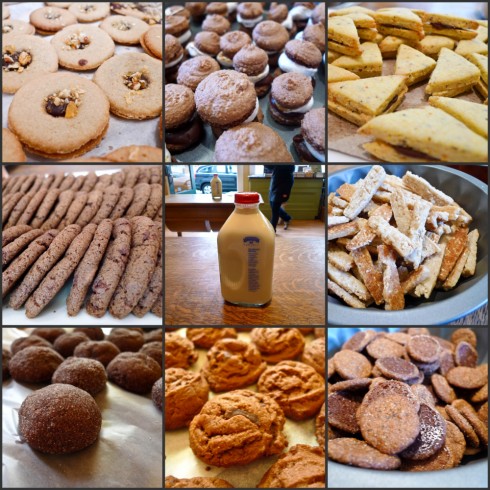
Off my sentimental soapbox for a bit, it’s time for another competition round-up from our little corner of the world at Omnivore Books on Food! We’ve had pies, fried chicken, pumpkin recipes, tomato recipes to name a few. This time, with cookies, I think we truly took it to another level.
Now, if you know me personally, you know my love for cookies runs deep. I can tell you that it is exactly an 11 minute walk to Anthony’s Cookies from Omnivore Books. When I test a new cookbook, if they have an oatmeal chocolate chip recipe, you can be sure that I’ll make it. (Mad Hungry is in the lead – see the top cookie shot there). If you are ever in the area near Brown University, you need to make a pit stop for a Meeting Street cookie, which a friend of mine once admitted that if she could, she would pro-create with one. Her grandmother, incidentally, makes a peanut butter cookie that rivals all others. And if you are ever able to make it to Big Sur Bakery, Michelle’s chocolate chocolate chocolate cookies are glorious, as are all of the varieties.
I share this all with you, because, being cookie obsessed I hold very high standards, and today I was very impressed. There was a real breadth of entries in this competition. I’m missing about five here, because in the end we sort of just exploded with cookies.
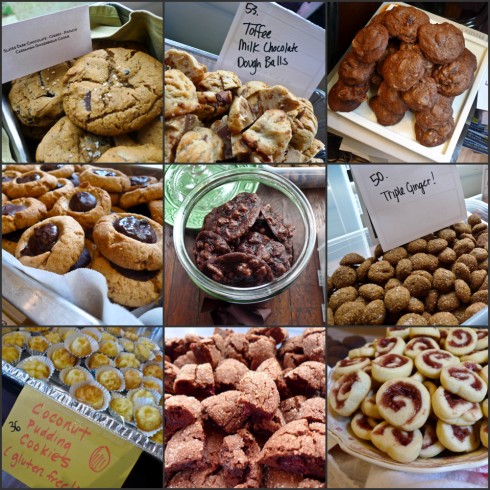
In no particular order:
Brown Sugar Toffee, Chocolate Chip, Chewy Almond Raspberry, Jacques Torres Spiced Chocolate Sugar Cookies, Orange Polenta, Chai White Chocolate Shortbread, Macadamia White Chocolate Chip, Caramel Cashew Choc-Oat-Ban, Toasted Walnut, Crispy Spicy Gingerbread Coins, S’more Macarons, Mayan Mexican Chocolate, Crispy Sesame Sticks, Chocolate Peanut Butter Sandwiches, Sugar Babies, Coconut Bars, Chocolate No-Bake Cookies, Chocolate Peanut Butter Fudge-gasms, Double Chocolate Mint, Cranberry Orange Pecan Oat, Coconut Pudding (gluten free!), Mocha Shortbread Chocolate, Salted Caramel Whoopie, Pecan Thumbprints, Raspberry Coconut Swirls, Mocha Squares, Chocolate Pecan Cherry, Mexican Hot Chocolate, Chewy Quinoa Raisin, Lemon Ricotta, Uncle Bill’s Cookies, Chocolate Spiced Cherry, Chocolate Chocolate, Double Chocolate Cherry Toffee, Chocolate Espresso, Triple Ginger, Lavender Shortbread, Salted Peanut Butter Triple Chocolate, Salted Chocolate Cherry Pistachio Cardamom, Toffee Milk Chocolate Dough Balls, Lemon Rosemary, Almond Butter, Cowboy Cookies, Oatmeal Chocolate Chip, Monster Cookies, Peanut Butter Chocolate Chip, Perfect Chocolate Chip, Sable with Black Tea and Plum Jam, and Chocolate Toffee with Sea Salt.
I was happy to see so many people I know, and meet lots of new folks as well. (A quick shout out here to Irvin whose wonderful blog Eat The Love just got a nod from Saveur because he is a rockstar!!! And, because I met her for the first time last week, one to Annie the Baker, whose dough balls are the stuff of legend.)
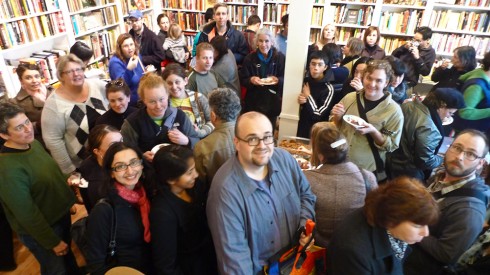
The second place winner – who in my post-sugar-coma I neglected to write down her name – won for her Salted Peanut Butter Triple Chocolate Cookies. As I started tallying the votes, I realized that I hadn’t tried one of these yet, and they were heading clearly to the lead. I’m glad that I snagged one before they were all gone! For her success, she won a coveted year long membership to The Bakers Dozen.
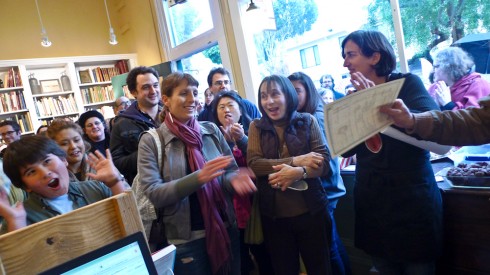
The winner, Julie Wise, won $150, with her Chocolate Toffee Cookies with Sea Salt. She entered the contest at the urging of her son, and is donating the winnings to his school, Mira Loma! So, pretty much, she also deserves an award in the coolest mom category.
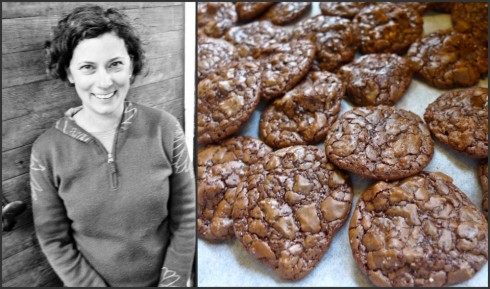
Here is the winning recipe! Now I’m headed to sleep off the sugar coma. Celia, I believe, is a better woman than I, and last I checked twitter is heading to IN-N-OUT. That is dedication people. Have a great rest of the weekend everyone!
Chocolate Toffee Cookies
Adapted from Smitten Kitchen, where it was adapted from Bon Appetit
* * *
1/2 cup all purpose flour
1 teaspoon baking powder
1/2 teaspoon salt
1 pound bittersweet or semisweet chocolate, chopped
1/4 cup (1/2 stick) unsalted butter
1 3/4 cups (packed) brown sugar
4 large eggs
1 tablespoon vanilla extract
5 1.4-ounce chocolate-covered English toffee bars (such as Heath), coarsely chopped
1 cup walnuts, toasted, chopped
Flaky sea salt for sprinkling (optional)
Combine flour, baking powder and salt in small bowl; whisk to blend. Stir chocolate and butter in top of double boiler set over simmering water until melted and smooth. Remove from over water. Cool mixture to lukewarm.
Using electric mixer, beat sugar and eggs in bowl until thick, about 5 minutes. Beat in chocolate mixture and vanilla.
Stir in flour mixture, then toffee and nuts. Chill batter until firm, about 45 minutes.
Preheat oven to 350°F. Line 2 large baking sheets with parchment or waxed paper. Drop batter by spoonfuls onto sheets, spacing two inches apart. Sprinkle with a pinch of flaky sea salt, if you’re using it. Bake just until tops are dry and cracked but cookies are still soft to touch, about 10 to 13 minutes. Cool on sheets. (Can be made 2 days ahead. Store airtight at room temperature.)
by Sam Tackeff | Oct 16, 2010 | Books, Food Travel, omnivore books
 (photo: Nader Khouri Photography)
(photo: Nader Khouri Photography)
I don’t get star struck. There is something about the notion of being starstruck I find completely absurd. Girls going apoplectic over a 15 year old “hottie”? Waiting for five hours in the broiling sun to get a glimpse of an actor? Or stalking your favorite pop star for that matter? I just don’t get it.
But then again, I’ve been trying to shake the weirdest feeling. One of those feelings where I’ve been run over, had my first kiss, finished a marathon, and won a million dollars… all in the same day. Shit. Is this what being star struck is like? It has been a week since I had the pleasure of hosting René Redzepi here in San Francisco, and I’m still feeling all a quiver.

(Photo: Phaidon Press)
Let’s be clear here, I had no idea what I was getting myself into. With Celia on vacation in Istanbul, I’d been manning the fort at Omnivore for a few weeks. Sure, I had no problem running a few events. Rock Star chefs? I can handle it. No problem Celia!
And then one day it started – a delivery man came with an entire palette of boxes.
Inside? The Noma Cookbook. 1300 pounds of the Noma cookbook, to be exact. It’s an obscenely beautiful book, put out by Phaidon, weighs nearly five pounds, and is covered in gray cloth. Three quarters of the book are striking photos of the gastronomic creations that have catapulted René Redzepi’s Noma to stardom; this year, Noma has been named the best restaurant in the world.

(photo: Nader Khouri Photography)
On Sunday night, I couldn’t sleep. Thinking about the Monday lineup was exhausting. A three o’clock signing at the bookstore, close up shop, take all the books and head over to Delancey Street Theater for a two hour talk with Redzepi and Daniel Patterson, check people in, sell books. Racing thoughts kept me awake, terrified. What if I can’t handle it? What if we screw up? What if someone has broken into the bookstore and stolen all 1300 pounds of books — a serious fear brought on by my sleepless delirium.
In hindsight, of course, I had nothing to worry about.
What can I tell you about René Redzepi?
In only a few hours I was able to unequivocally deduce that he is one of the most gracious, intelligent, driven people I have met. (He also has a voracious appetite for knowledge, and snagged some of my favorite historical books on food, including rare copies of Jane Grigson’s Vegetable Book and Fruit Book, and Marinetti’s The Futurist Cookbook.) He took the time to sign and personalize every book, take pictures with adoring fans, and joke around in between. And he’s adorable.
When he spoke, I took notes – 12 pages of notes – which I’m going to do my best to recount without sounding like a rambling idiot.

René Redzepi and Daniel Patterson Do Stand Up
What happens when you get two chefs on stage together and a captive audience of 150 people? Somehow, they both managed to utter the phrase Seal-Fuckers and everyone finds it hilarious.
For two hours, what unfolded on stage was something incredible. Something I believe everyone will be thinking about for years to come. A combination of a comedy routine, storytelling, and critical analysis. I think it’s safe to say the audience was thoroughly moved by the presentation.
In his introduction, Daniel Patterson – of Coi in San Francisco and the newly opened Plum in Oakland – was clearly excited to be sharing the stage with Redzepi. And who wouldn’t be, really?
Patterson described Redzepi as the master of “cooking from your own place”, and extolled what makes him the best in the kitchen: “Intuition – he’s a scary good cook. Super distinctive and sharp. Watching his mind work? So, so, fast.” To be a chef of this caliber, it is not just about skill, it’s also something deeper. “There’s an incredible warmth, a very strong emotional foundation. There is real joy.”
As the talk commenced, the audience was instructed to look through a little cloth bag under each seat filled with freshly foraged herbs, hay, and a small packet of Angelica root (known in Chinese medicine as Dong Quai). As you opened the bag, fragrance exploded and you were instantly transported to the forest. The bag was so fragrant, in fact, that after leaving it overnight in my leather purse, I’m beginning to believe it has permanently scented my handbag.
It Starts In Childhood
Some of Redzepi’s earliest influences were from an upbringing spent traveling between Denmark and his father’s native country, Macedonia.
In Macedonia, if you wanted food, you grew it. And what you didn’t grow, you traded with your neighbors, or perhaps picked up at the baker. Driven mostly by poverty, but also a sense of pride in their own food, life there was back to the land. The people were poor but not wanting in good food.
It’s not surprising to hear Redzepi didn’t drink soda until he was an adult. Special drinks were syrup over rose petals, or milk (provided that you milked the cow), but mostly, there was water.
In contrast, Denmark in the 1980’s was captivated with the microwave and ready meals. As a child, Redzepi recalled some embarrassment about heading to Macedonia (particularly while his Danish peers were off spending their summers in Italy or France). In hindsight, experiences foraging, farming, and eating from the land have only served him well. His family grew peppers and watermelon. Watermelon, he joked, is the perfect food:”You eat, you drink, and you wash your face”.
But good things don’t last forever, Redzepi lamented, “when the war came, people fled, and slowly as they have returned, life in Macedonia has become more Westernized. They used to sit on the floor, eat with fingers from platters of food as a family, and everything was cooked.” But that is no longer true, and as we are seeing all over the globe, cultural legacies are being lost.
Education Leading up to Noma
When he entered chef college, he became instantly smitten by cuisine. Originally, Redzepi assumed he was going to do his version of French food, but then he went to stage at El Bulli in ’98 – and ’98-2002 was a great time for the restaurant. “For me, I left that place with such a sense of freedom.” From there, he headed West to California for a stage at French Laundry.
At French Laundry, he was further energized. Here was a great Chef [Thomas Keller] with such a strong signature – “An American chef doing something American”, with ingenious dishes like “Coffee and Donuts”.
After traveling the world, the passion to do something new, unique, really something uniquely Danish, was solidified.
And so, seven years ago, he opened his first restaurant, Noma. He was 25.

Noma is located in the Christianshavn area of Copenhagen, Denmark. The building’s original use was as a warehouse for North Atlantic imports, and the rooms that the restaurant is housed in were used to store salt. The owners wanted a chef whose cuisine could in some way reflect the history of the place. And so, Noma moved in, with a noble goal of creating “high gastronomical cuisine using what was around us.”
At the time, basically all top level restaurants in Denmark were using European products. It was the standard. There was such a disbelief in the project. “It’s amazing how little faith we ourselves, the people, had in our own products.”
What unfolded was what Redzepi described by quoting Schopenhauer: “All truth passes through three stages. First, it is ridiculed. Second, it is violently opposed. Third, it is accepted as being self-evident.” (Yes, the only chef I’ve heard quoting German philosophers.)
To put things in perspective about how hard they worked, Redzepi wasn’t happy even receiving their first Michelin star within a year of opening the restaurant. “At first, there were still too many reference points from other cuisines.” The idea of being local is easy. The difficult part is how you take “local” on the plate and make it work.
And so they started seven years ago rediscovering ingredients “so that they taste of their own place”. Chefs often read a lot of recipe books to draw inspiration, but Redzepi found that he needed to start reading other books – history books – to learn what people ate over the ages. And he spent a lot of time talking to historians.
As we listened to Redzepi describe this, Patterson shook his head in admiration: “There is a determination – Rene works a lot. He’s worked his ass off for years. There is a constant pushing.” To which Redzepi replied: “If you don’t have patience and commitment to the extreme and are not manic in your pursuit for this, it can’t happen. You have to work for this.”

Five Dishes
At this point, although I could have listened to hours of just conversation, we got to see a video of five dishes with notes from nature to plate. Most of the dishes at Noma are created with nature as the direct influence. Redzepi explains: “A lot of people ask “why is it so landscape-y?” It’s a reflection of where we go, walk, live….this is just the way things have shaped.”
The cuisine at Noma is so dependent on the weather and the seasons, it can change every day.
Redzepi began by introducing the ingredients he works with: “In Denmark, if there is any prejudice against our region, it’s that it is extremely cold and people think no ingredients can grow. But it’s a matter of determination and hard work.”
Taste is integrally linked to place. He explained (without prejudice) that things in America taste almost overly sweet to his palate – which happens to be because produce here has so much more time in the sun, than in Denmark where the flavors are much more mineralized because the plant gets nutrients mostly from the ground in their harsher climate.
Each dish has its own story, and unfolds with whim and novelty.
There was ‘Asparagus and Spruce’, where the green asparagus tips are grilled, then juiced. They add a touch of spruce oil, and then wrap white asparagus around actual spruce leaves, top with the juiced asparagus, and add a touch of whipped cream.
Or the ‘Steamed Oyster’, composed of the oyster, as well as plants sourced from the land around the oyster flats. So you have these native oysters, and then unripe pickled elderberry, and the dish is created by pouring seawater on, and steaming it in almost its natural environment.
Or “The Sea”, where a dish is composed from sea herbs rich in vitamins, sea water, rocks and beach plants. Topped with dried shaved urchin roe, arranged as if they were in their natural environment.
Or the ‘Hen and the Egg’, where the chef thinks what is a chicken? The whole dish is created from a starting point (the hen house) and the meal is created completely from ingredients a few feet around it. The egg, the hay from the coop, the herbs the hen eats. And then the whole dish is interactive – the diner actually puts together the dish and eats it.

My favorite dish however, was the ‘Vintage Carrot’, because it truly reflected the essence of the creativity on display at Noma.
A vintage carrot is actually a vintage ingredient.
They were having a winter like Ragnarök (the Norse mythological version of Armageddon), and it was “so crazy cold”. The chefs were running out of things to cook at Noma, and were desperately working with their farmers to find something they could serve. One farmer had these old hideous carrots he had left in the ground for a winter, and then stored them in his larder. They were year and a half old carrots. So they thought to themselves, how would you cook a carrot like this?
Maybe like you would cook a piece of perfectly aged beef – with as much care as possible. “So we wanted to do that with a carrot. What would happen if we gave the same care to a shitty old carrot?”
And so here is this dish, composed of vintage carrots, gently cooked with wild chamomile and sorrel in goats’ butter. They cook it, very slowly, an hour, hour and a half, and then suddenly it’s the carrot of their dreams.
And then he thought: SHIT. What if we are now eating the wrong carrots? What if this was the RIGHT carrot? The way carrots are supposed to be? The authentic carrot?
“So we asked the farmer – what other old shit do you have? Give us your crap! And then he got us vintage potatoes…” so the story goes.
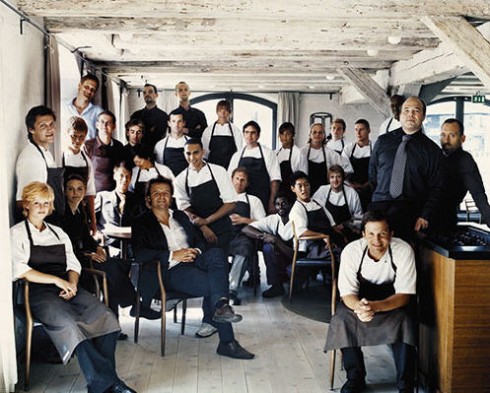
CONVERSATION AS THE FOUNDATION
“The importance of people and the importance of conversation is just about everything for us.”
After fully transfixing us with food, the conversation returned to the work they put into the restaurant. Possibly the only frustration I have with the Noma book is that the front section on the day to day happenings of the restaurant is only a handful of pages. (Maybe that’ll be the next book.) Listening to Redzepi, these details are clearly things that he has thought long and hard about.
Noma has 20 full time employees, and 5-8 stagiers (interns – for one to three months) at any time, and the empowerment of each and every team member is an integral part of Noma’s success. The work is highly technical, and many people are involved in each and every dish. All this for forty covers a night. “The kitchen is full of good people, free thinking people – people who take standpoints on what they are cooking,” he went on. “Our trade is one of the last trades that will never be replaced by machines… you need to think”.
In addition to the hard working kitchen staff, they also work hand in hand with the farmers. Noma has a large network of farmers and foragers. They worked hard to cultivate these relationships. Just by giving feedback and respect to the farmers (a group of people, on the whole rarely congratulated for their hard work), they found these people striving to do better. “There is a sous chef in the kitchen to make sure the farmers feel that they are a part of us… They get Christmas cards every year, and every year they are invited to eat at the restaurant. We are having so many conversations with them constantly. If these people were not on the team, we wouldn’t have a restaurant.”
To further the education of his kitchen, Redzepi detailed several ways to make a better chef:
1. Make them harvest, prep, cook & serve. (Instill the feeling of giving.)
Each of the staff at Noma are taught to forage and harvest, which changed how the kitchen thinks about food. Chefs are usually trained to work within the format of recipes, but Redzepi knows first hand that chefs start changing when they really know how things grow. There is something so important about the conversation in nature, “I know it sounds a bit wacky,” Redzepi chuckled, “[but you need to have] a conversation with the plants in the forest. There is something so valuable about learning the essence of taste from the source in its perfect element. You know, the way it should be. How much would you allow yourself to do with this ingredient? [This] reflects how you treat an ingredient in the kitchen.”
How can a restaurant have the same feeling of giving if they charge for their meals? The chef was quick to make note that “in a perfect world, all restaurants would be free”, which he amended: “In a perfect world, all restaurants would be subsidized by the government.” [The audience laughed.]
By requiring everyone to have the opportunity to serve, you create better chefs. Actually seeing guests, they take a better standpoint on cooking. It’s the feeling you get as a parent feeding a child – you want to provide the best and most healthy and perfect food – they adopt the same philosophy for their diners.
2. Every Saturday they have an innovation practice in the kitchen, after service (about 2 am). Everyone has worked 75-80 hours or more. Each section has a head chef who creates a dish – the purpose is to “make chefs take a standpoint on what they enjoy about food.” In the beginning, it is very difficult – but week by week – people get better, stronger. They start really developing themselves as chefs.
This is one of the many reasons chefs around the world fight to work in Redzepi’s kitchen.
* * *
As the conversation neared its close, a member of the audience asked Redzepi “What’s next?” to which he replied:
“The biggest joy is now having complete freedom to cook what we want.” Redzepi laughed, “If we want to put reindeer balls… or beaver snout… we could put it on the menu, and people will try it.” Next is the same… until there is no more inspiration. “I have a personal vision of keeping learning throughout my life, and keeping my family learning.”
“Year by year, season by season, you start to understand more, and it starts adding up.”
* * *
As people filed out of the theater, my admiration was only reaffirmed, as René stood next to me while I sold books, and he personalized them, chatted, posed for photos, and put a smile on peoples’ faces.
Am I star struck? Maybe. A little. But, I’d like to think my jitters came from experiencing a critical moment – one where I was forced to think hard about what I had thought was true. I had to accept something new and profound. After seeing someone with so much passion, dedication, and thoughtfulness, a small part of me regrets not becoming a chef. But for now, I’m taking the time to think about what this will all mean for me. Who knows where life will take me?
And so, here, I share one slightly embarrassing photo that Emily took of us, (give me a break, I’d been working like a fiend the entire day), and would like to take a moment to say thank you to everyone who made this day possible.
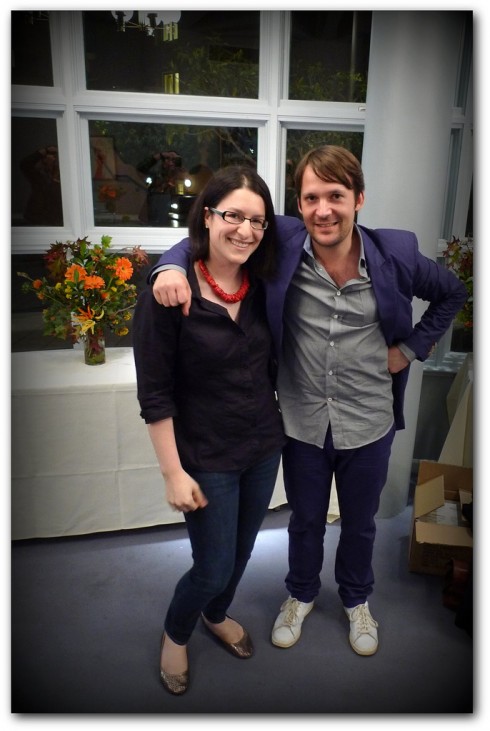
Noma: Time and Place in Nordic Cuisine (Phaidon Press, $49.95) by René Redzepi, www.phaidon.com
by Sam Tackeff | Aug 19, 2010 | Asian, Books, omnivore books, Restaurants
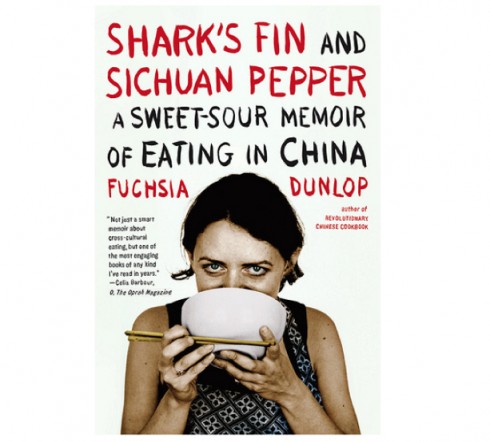
Summer isn’t over yet! (Really, it’s just beginning here in San Francisco). For anyone looking for some good summer food reading – look no further! There is still time to hit the beaches and don your sunhat with a good book! Here is the official Omnivore Books Summer Reading List – for those of you who haven’t seen the newsletter – here is the list (I have in fact, read every single one of these books, and enjoyed them myself):
OMNIVORE’S 2010 BEACH READS
By far, one of my favorite books on this list is Fuchsia Dunlop’s ‘Shark’s Fin and Sichuan Pepper: A Sweet-Sour Memoir of Eating in China‘. Perhaps I’m biased because one of my oldest childhood friends lives in Shanghai, and I feel a kinship to those who write about China, and perhaps my bias extends from my love of Chinese food instilled from my father’s very good Chinese cooking skills (he learned from an Asian grandmother whom he exchanged grocery shopping for her for cooking lessons), but nevertheless there is something visceral that comes up every time I get to recommend this book to someone.
When people come into Omnivore asking for their next good read, I usually direct them towards this book and start waxing poetic and verging on desperation. You MUST read this book. I’m not sure how I would even describe this woman without babbling about how cool she is and how much I admire her tenacity and how much I want to be like her. Here I am doing it again.
Above all, I love reading books by smart, motivated, strong women. There, I said it. Some of my biggest role models are writers such as M.F.K. Fisher, Elizabeth David, and Judith Jones. These women inspire me every day. In brief, Fuchsia Dunlop is certainly one of these women I admire: a witty and persistent Englishwoman, who rather than taking the safe and comfortable route, decided to study abroad in China during her University years. People just didn’t do that in the 90’s. Her brief stint led to a lifelong passion – she went back to live there, and ultimately managed to stumble her way into becoming the first westerner ever to attend the Sichuan Institute of Higher Cuisine.
Ultimately she went on to write two cookbooks, ‘Land of Plenty: A Treasury of Authentic Sichuan Cooking‘ and the ‘Revolutionary Chinese Cookbook: Recipes from Hunan Province‘ which are both excellent resources for Sichuan and Hunanese cooking. Beyond the cookbooks, it was a good thing she went ahead and wrote her memoir. Her voice on the page is clearly one of a woman I’d love to go gallivanting off to the ends of the earth with.
Throughout the book, Dunlop has this wonderful way of describing the tastes and the essence of food, and ‘Shark’s Fin and Sichuan Pepper: A Sweet-Sour Memoir of Eating in China‘ is full of amazing, bizarre, and sometimes even shocking tales. I found myself reading through this book – giggling, getting hungry, and experiencing her remarkable journey as a vicarious travel partner.
The Bottom Line: I highly recommend this book.
And then, of course, once you read it, you too can join the ‘Fuchsia Dunlop Admiration Society’ (OK, so I made that up) and can follow her on twitter! Now if only we could get her to come on vacation and speak at Omnivore! We’ll have a party!
* * *
And now, while we are on the topic, here are a few photos from a dinner I had with fellow food bloggers quite some time ago at Sichuan restaurant Z+Y in San Francisco’s Chinatown. Totally Authentic? Not quite, but it was delicious nonetheless.
I’ve had a soft spot for Sichuan since I was a child, mostly because one of the better Chinese restaurants in our slightly sleepy corner of New Hampshire was called Szechuan Taste. There was one in Portsmouth, and then they opened another one in Exeter conveniently located blocks away from my high school. I can’t really vouch for the authenticity of the food, as they became very Americanized over the years, but I loved the place and have fond memories that guided my pursuit of knowledge into Chinese cooking, so I have to give them credit where credit is due.
At Z+ Y, we ate (somewhat gluttonously, between eight of us): Scallion Pancakes, Spicy Numbing Beef Tendon, Yunnan Style Steamed Chicken Soup in Clay Pot, Peking Duck, Pea Sprouts with Garlic, Special Pork Belly (not on the menu), Chicken with Explosive Chili Peppers and Hot Braised Sea Bass, Cured Beef Wrapped In Scallion Pancake, and Red Bean Buns for dessert.
There is something really reassuring about eating dinner with food bloggers. For one, you don’t have to feel any embarrassment about taking photos of the food, and really the phrase “WAIT – let me just snap a few photos please!” even remains unsaid. Although, to be fair, Devon is very good about waiting patiently for me to take my photos at dinner.
Bloggers in attendance: @cookingwithamy @chefjen, @urbanstomach, @summertomato, @alphaprep (yep that’s me), @divinacucina, @heatherhal and @Jeters.
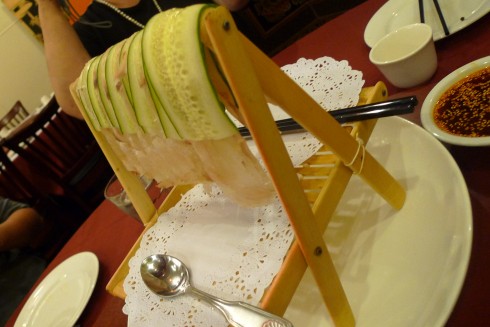
Another thing about eating with food bloggers is that you can order half of the menu and not skip over the bits and pieces of the animal for fear that your dining partners will not be so keen on your choice. And so here, a dish that we all (or mostly all) enjoyed: Tendon. It’s not just for pho! I can’t get over the fact that it looks like I’m being served food on an easel. I really got a kick out of this dish. The beef tendon was shaved thinly, and served with a tingly numbing sauce.
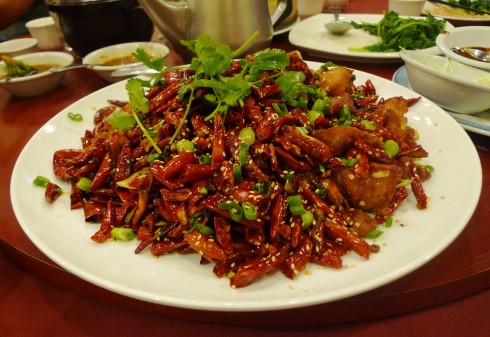
We food bloggers also really appreciate highly photogenic foods, such as this Chicken with Explosive Chili Peppers. Massive piles of fiery peppers in contrasting red and green! I’m fairly sure this had more peppers than would be needed or wanted in the home, but it made for an exciting presentation.
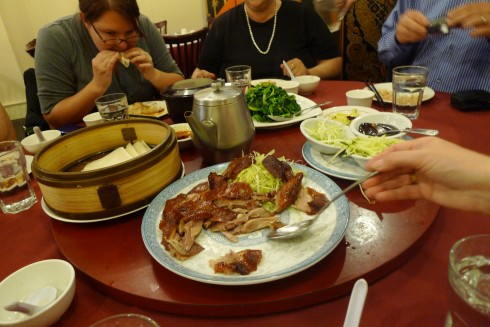
And then there was the duck. Apologies to @jeters for the “in the moment eating shot”, but I had to put this in as it was the only shot of the duck I managed to take. I’ve been a devotee of duck since my childhood where my favorite memories of Chinatown were the ducks hanging in the windows. I’m sure my parents were slightly concerned about my excitement – I was at that point fully aware of the live happy farm duck being the same, in theory, as the dessicated hanging duck in the window – and I still would ask to eat it pleadingly.
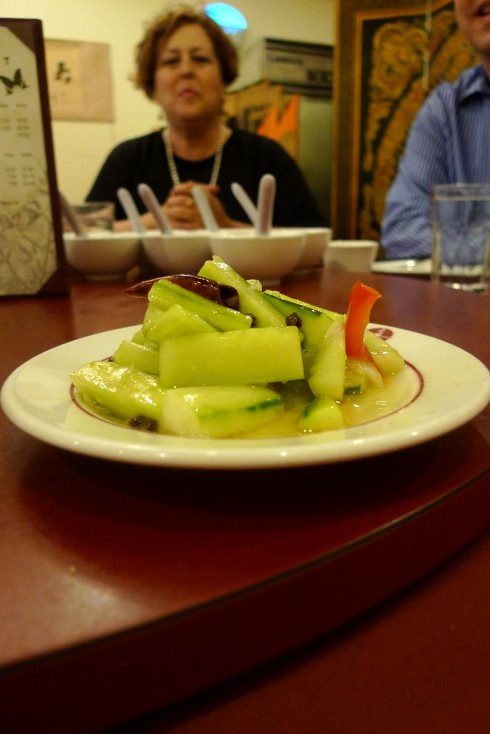
A great part about the food blogging community is that you can eat with people that you greatly respect and admire, and even if their work is heralded across the globe, perhaps in bookstores, or written about in famous magazines, even the best food writers will gather to share a meal – food is something we all have in common. The lovely and talented Divina Cucina in the background (for whom this dinner was in honor of), and quick pickled cucumbers in the foreground.
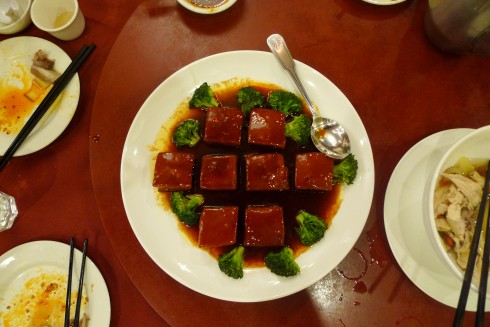
Food bloggers also have gumption and forethought to order in advance, and throw their hands into the air and say feed me the best you can! The Japanese have a word Omakase, or Chef’s Tasting Menu, that is in the spirit that I like to eat – allowing the chef to choose the best, the freshest, the most interesting foods, and as a rule, I always defer to their suggestions for which I’m often highly rewarded. The pork belly – not on the menu, but at the recommendation of the chef was delightful – a current food trend, pork belly has been a delicacy for hundreds, if not thousands? of years, and prepared simply, this was one of the better experiences with pork belly I have had to date.
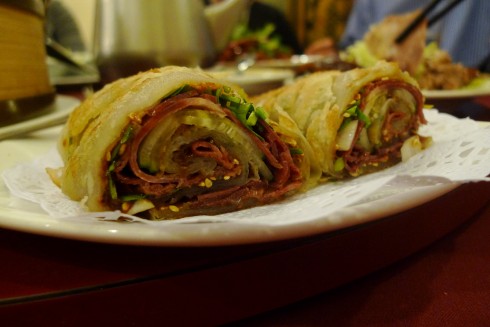
And then there is that moment in many a meal, where sometimes, even seasoned food bloggers are slightly perplexed. In this case, the moment was when we were served the cured meat wrapped in scallion pancake – Chinese-Jewish fusion food? I wasn’t able to grasp the influence, but I liked it!
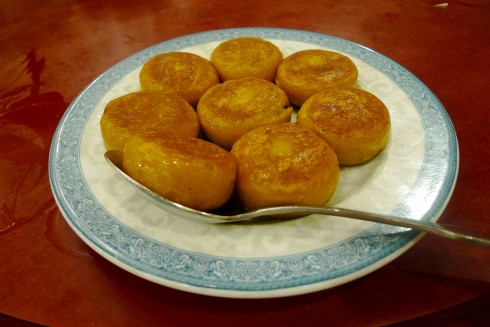
Finally, we ended with red bean buns, and slices of orange, which, although I do have some fabulous photos of friends making awkward orange smiles, I’ve held back at posting them, perhaps though, they’ll serve as future blackmail.
For more perspective, check out Alex’s write-up (same dinner, lens across the table). And for even more convincing, Marcia (The Tablehopper) also had a great writeup of her dinner a month ago.
Z&Y Restaurant, 655 Jackson St, between Grant & Kearny
415-981-8988
Monday-Sunday 11 AM-10 PM
Pre-Ordered Nine Course Meal For Eight: $200 after tax and tip (sans beverage)
by Sam Tackeff | Jul 17, 2010 | Baking, Challenge, omnivore books
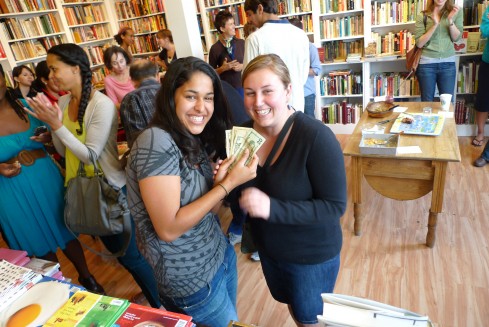
Another smiling shot of the winners (Aleta and Lilly) of an Omnivore Books Food Contest. This challenge: Stone Fruits. The entries were all diverse (okay, except maybe for a noticeable trend of peaches) and everything was delicious. Despite my resolution to keep my tastes to a minimum, I end up trying everything, and eventually went back to seconds. Damn deliciousness breaking my willpower…Here are all photos of all of them to drool over.
The winning dish?
An Assortment of Galettes. These charming galettes were the clear favorite. Excellent dough, and creative fillings. The dough was a
Pâte à Foncer dough from ‘Advanced Bread and Pastry A Professional Approach’ written by Michel Suas. I’ve attached the recipe at the bottom – perfect for summer baking!
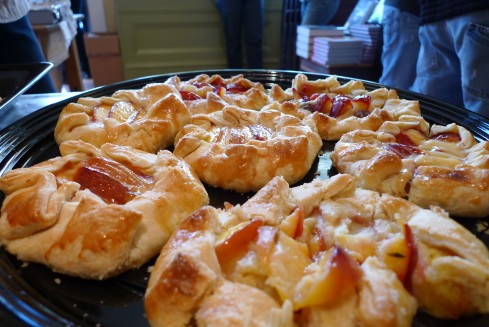
The runner up was Lisa’s individual Financiers with Peaches, Almonds, and ‘lotsa Butter! Let me just say that these were some of my favorites – I’m a sucker for classic french pastries.
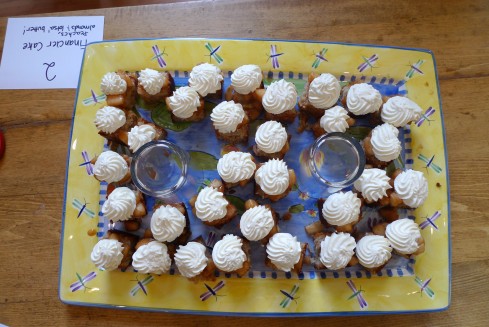
Our own Paula brought a lovely Peach Cobbler, which had the glorious addition of a little bit of almond extract, that I must remember to add to my own. It’s a wonderful marriage of flavors.
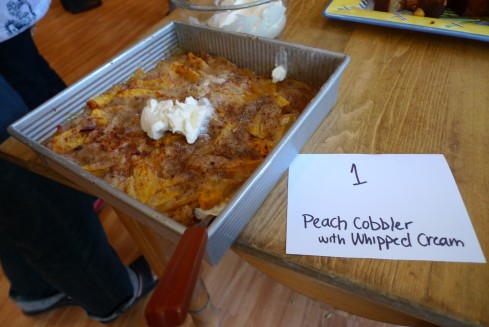
A savory Peach and Nectarine Salsa was served with chips in this absolutely adorable vintage serving dish. I’d like to get one of these! The salsa was incredible, but the entire presentation was a feast for the eyes. I can see bringing this to every summer cookout.
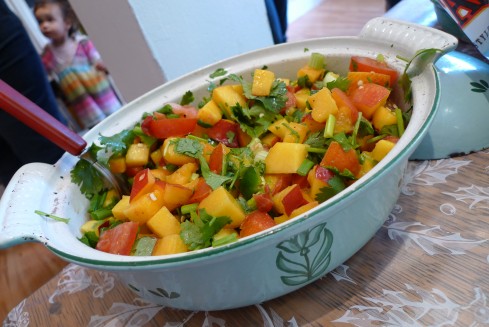
A Two Plum and Peach Pie was served elegantly on a raised platter (points in my book for presentation), and I loved particularly the way the plums were treated – they had an intense flavor.
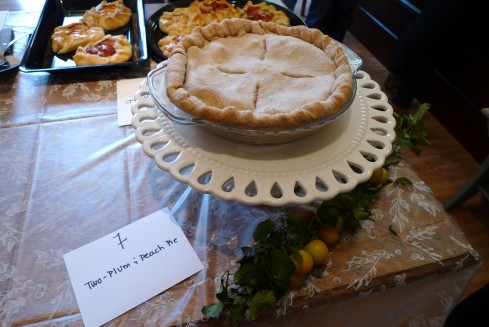
A jar of plum jam. Sweet and to the point. I could see this being consumed very quickly in my house, probably equally on toast and stirred into a morning yogurt parfait.
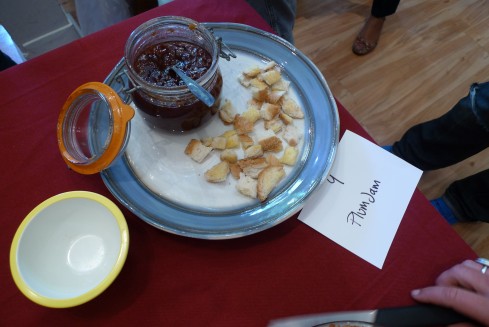
Peach and Nectarine Pie – quite a classic pie, with nice addition of cutout circles of dough adorning the top of the pie there.
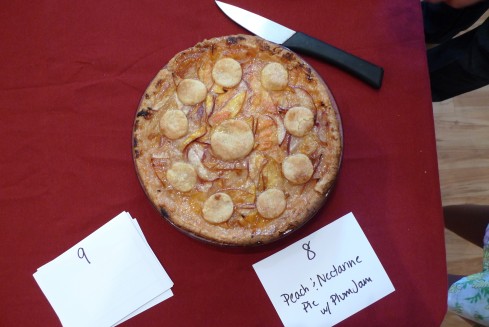
Apricot Clafoutis – one of my favorite French desserts. And so easy to make! This version with Apricots was lovely. (The chef also recommends chocolate and cherry clafoutis. I think I’d have to second that – maybe it will be my next baking project.)
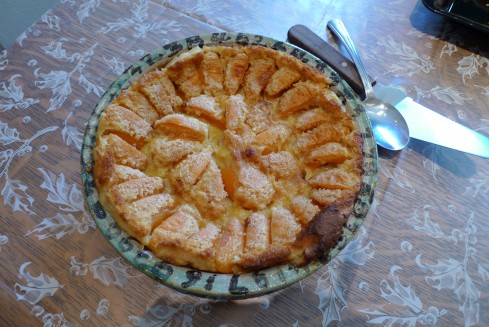
Italian Pistachio Plum Cake (and it was vegan!) – a delightful, almost spongy (in a good way!) pistachio cake dotted with the perfect little plums. And it came with a delicious jam (with an extendable spoon to boot – making for the perfect competition servingware) .
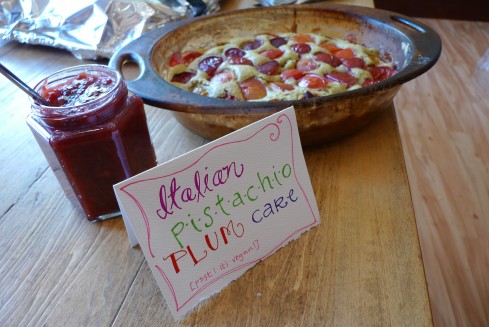
Savory Plum Tarts – the last entries into the competition, a little late but they certainly held their own! Came in two flavors – one with thyme, rosemary and lavender jam, and the other with basil, honey, and balsamic.
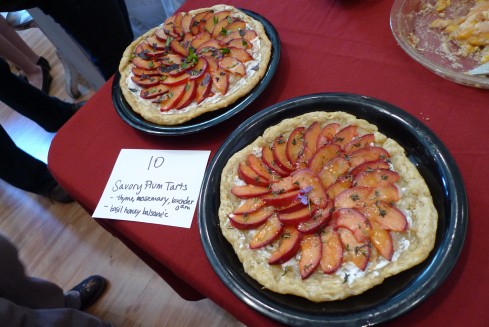
Jealous?
Don’t worry! We have another contest coming up next month: Tomatoes!
Tomato Cooking Contest! Omnivore Books – August 14th – 4-5pm. Bring a tomato dish, sweet or savory, or just come to eat with $5 dollars in hand ready to judge your favorites. Winners split the door money and earn serious bragging rights.
* * *
Pâte à Foncer
from ‘Advanced Bread and Pastry A Professional Approach‘ written by Michel Suas
Don’t be put off by the metric measurements – baking in metric is much more precise and yields better results. And it’s incredibly easy to find a kitchen scale – mine that tares from metric to standard US I purchased at Ikea for about $12.
yields about 6-7 5inch galettes
Ingredients:
395 grams Pastry Flour
296 grams Butter
79 grams Milk
16 grams Egg Yolks
8 grams Salt
6 grams Sugar
Method:
1. Preheat oven to 425ºF along with a sheet pan or pizza stone (385ºF for convection oven).
2. Allow butter, milk, and egg yolks to come up to room temperature. Butter should be almost mayonnaise consistency.
3. Soften the butter and mix with the paddle attachment.
4. Add the salt, sugar, yolks, and milk, and then add the flour. Mix until just incorporated; dough should look a little bit shaggy.
5. Refridgerate dough for 1 to 4 hours.
6. Divide dough into 7 pieces. Roll dough out to about an 1/8 of an inch thick about 6-7 inch rounds. Fill with either sweet or savory filling. Egg wash crust.
7. Bake until golden about 25-35 minutes.
by Sam Tackeff | Jul 2, 2010 | Books, Food Travel, omnivore books, Soups
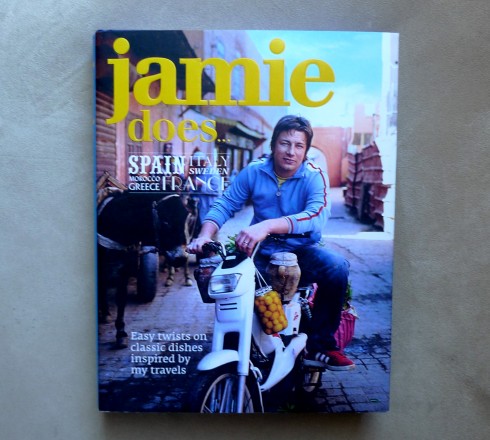
I have a little secret to share with you. Ok, so it’s not a secret to anyone who knows me, but, I happen to be obsessed with Jamie Oliver. It started in 1999, right around when we first got cable television, I discovered the Food Network, and then I discovered the Naked Chef. It was one of the first cookbooks I cooked through. I should have blogged about it. Oh well. When Jamie married Jools, I put his photo up next to my bed (which I had clipped from my grandmother’s People Magazine) and cried a little bit.
I can’t believe that it was over 10 years ago. Now, 14? 15 books later? He has come out with a new one – except it isn’t out in the states yet. Jamie Does is another brilliant book from Jamie Oliver that I encourage you to get your hands on. Don’t be put off by his media presence – he is legit – I assure you this man can cook seriously good food.
I took home a copy of ‘Jamie Does‘ about a month ago from Omnivore, and could not be more excited about it. It’s a fantastic cookbook. The premise is based on Jamie’s travels across Europe and North Africa (Lucky Bastard!) : he heads to Spain, Italy, Sweden, Morocco, Greece and France, searching for the flavors, techniques, and recipes of each country.
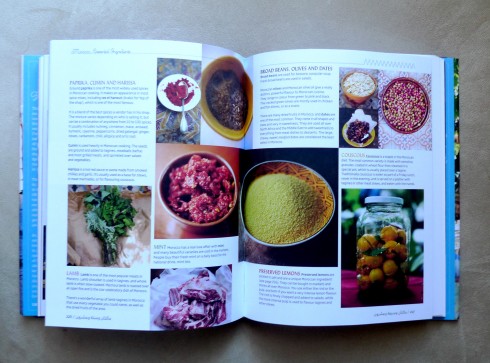
There are so many reasons I love this book (aside from the fact that everything Jamie Oliver does is wonderful,) but my favorite part are these beautiful spreads of the main flavor components and ingredients of each country. The tagline of ‘Jamie Does’ is “Easy twists on classic dishes inspired by my travels”. So many people are afraid to cook new types of cuisines, but as long as you have the flavors and the general cooking techniques, you can fiddle around and make things taste delicious and fairly authentic.
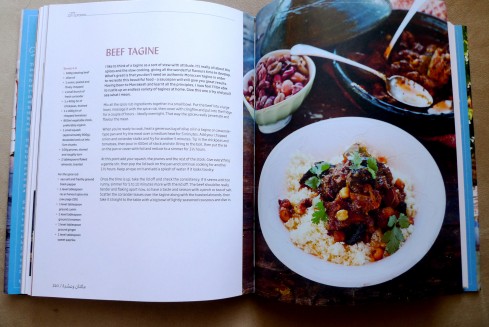
Each page of this cookbook is filled with beautiful spreads and photographs by David Loftus – real food that you want to eat, and feel empowered to prepare. You don’t have to go to these places to eat, you can travel right in your own kitchen. (Although, frankly, this cookbook makes me yearn to whip out my passport and my credit card and make reckless financial decision…) And yes, there is a tv show. I’ve been watching the grainy version on youku, because British networks are cruel, cruel people and will not stream online to the U.S. audience.
Here are links to more of Jamie’s recipes: head over to his website to access hundreds of his recipes . An incredible resource!! And of course, he’s on twitter, too. Now if only we could get him to Omnivore Books for a signing….
* * *
Last night I put together a quick summer minestrone soup with some of the contents of my farm box. I also had a loaf of bread that our neighbor baked, which needed to be eaten, and I decided that soup would be the perfect accompaniment. After searching for the proper treatment for my veg, I was inspired by the ‘Spring and Summer Minestrone’ in ‘Jamie Does‘
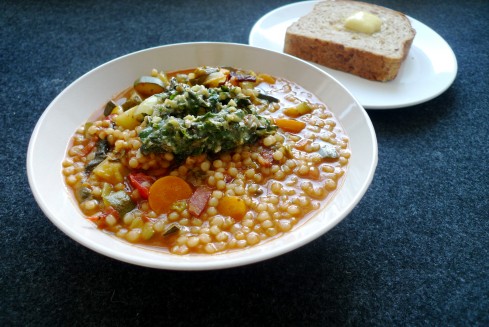
Spring Minestrone with Pesto
adapted from ‘Jamie Does’
Serves 2-3, 25 minutes
In a heavy bottomed pot, heat a glug of olive oil. Saute an onion, a couple of chopped carrots, a few cloves of garlic, and a few slices of really good thick cut bacon, chopped. After those have been going for about 5 minutes, add in two chopped zucchini, and cook for a few more minutes. While that’s going, chop up a tomato, and a bunch of parsley, and whatever greens you have in the fridge, and stir it all in. Swiss chard? Kale? All I had was lettuce. It worked just fine. Add a handful of peas if you have them (I didn’t.) And then cover with some good organic chicken or vegetable stock. Bring to a boil, and add a small handful of pasta (I used 1/2 cup israeli cous cous). Season with salt and pepper, and turn down to a simmer for 10 minutes.
While the soup is going – you make your pesto. A classic pesto will have fresh basil, garlic, pine nuts, parmesan and olive oil. I had basil, garlic, walnuts, Kerrygold Dubliner with Irish Stout, and olive oil. It worked out just fine. I dumped a large handful of the basil into my mortar and pestle with a pinch of coarse salt, and bruised them well. I added a few cloves of garlic, a couple of walnuts, and made a paste. I grated in about an ounce of cheese, and loosened it all up with a few good glugs of olive oil.
When the pasta was cooked, I ladled it into bowls, and topped with a dollop of pesto. I toasted thick slices of the bread, and topped them with a pat of Kerrygold Butter.

















































